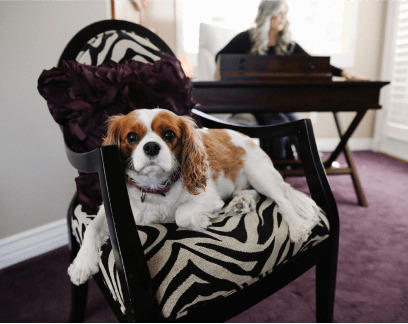Center the primary beam over the tibia and collimate to include the stifle and the tarsus (FIGURE 17). The difference between that angle and a perpendicular line to the mechanical axis is the tibial slope.a. ; UNIQUE! The third trained associate should be focused on positioning the patient. Understand the musculoskeletal, nervous and internal organ systems easily with these wall hangings in lamination or paper. If needed, tape can be applied around the tarsus to pull the femur down to get the femorotibial joint at a 90 angle. Cotton or a foam wedge may be used under the carpus or elbow to enable a true lateral position through the radiohumeral joint space. Our veterinary anatomy posters and anatomical charts are scientifically accurate. Center the beam over the axillary joint space of the leg of interest (FIGURE 28). The larger image depicts positioning for bulla and mandible. Kirk And Bistners Handbook Of Veterinary Procedures And Emergency Treatment, 9th Ed. The position of the patient for these views may depend on anesthetic depth. This Acupuncture poster is perfect for anyone who wants to learn and share the ancient healing art of acupressure and Acupuncture with their animals. If the patient is under heavy sedation or general anesthesia, it may be placed in lateral recumbency with the affected dental arcade closest to the plate or cassette. Collimate to include the wings of the ilium and a small portion of the proximal tibias, just caudal to the femorotibial joints (FIGURE 23). X-rays differ from some other forms of electromagnetic radiation because their very short wavelength allows them to penetrate matter, including cells. Vet Immobilizers & Positioning Veterinary positioning blocks and wedges provide excellent stability during any examination. This will help to visualize the toes individually on the radiograph. Dog muscle anatomy poster created using vintage images. Please use this content for reference or educational purposes, but note that it is not being actively vetted after publication. Several important factors must be considered if an accurate reproduction is to be made: 1. Occupational dose limits for adults. If the patient is under general anesthesia, be sure to either tie the tube to the mandible or remove the tube briefly for the exposure to prevent the tube from being superimposed over the maxilla. The patient is positioned in lateral recumbency with the affected limb closest to the plate or cassette. In some cases, I feel that this text may simply remind some readers of many useful, but less common (or forgotten) radiographic positioning techniques as well as tips for improving the common views. Extend the head back as far as it can go to prevent the trachea from being superimposed over the joint space on the radiograph. The patient is positioned in sternal recumbency. Dorsopalmar view (splay toe). The patient is positioned in sternal recumbency with a triangular wedge under the abdomen and pelvis. If the patient is large and very anxious, up to 3 people might be needed to ensure the safety of all involved. If needed, tape can be applied across the rostral portion of the mandible or behind the canine teeth on the maxilla to position the nose parallel to the table. This displaces the scapula dorsally above the dorsal spinous processes of the thoracic vertebrae. Radiography in Veterinary Technology. The fabellae may or may not appear symmetric; however, the diagnostic view should show fabellae that are bisected symmetrically by the epicondyles of the femur. Stay current with the latest techniques and information sign up below to start your FREE Todays Veterinary Nurse subscription today. Cone Instruments. The patient is positioned in dorsal recumbency. A diagnostic view of the extended pelvis shows the patellas centered, the femurs parallel to each other, the tuber ischia equally overlapped by the femurs, a symmetric obturator foramen, and the tail between the femurs (FIGURE 21). The patients nose should be pointing upward. Veterinary Radiology - Teaching and learning about veterinary diagnostic imaging. I feel a soul. Many veterinary technicians can relate to this quote and see the truth behind it. Now, people are more aware of the risks posed by repeated exposure to radiation, but that wasnt always the case. This view of the pelvis is considered the most diagnostic view. When pulling the head to one side, be careful not to rotate the elbow too far medially or laterally. +1 (647) 502 4843 info@handsfreexrays.com. 4. For example, if the left stifle is affected, position the patient in left lateral recumbency. Study Details: Radiographic Positioning: veterinary radiography positioning, Get more: Veterinary radiography positioningView Study, Study Details: WebAll veterinary professionals should practice simple methods of keeping exposure as low as reasonably achievable (ALARA), such as increasing distance from the tube head, using radiology positioning pdf, Url: Todaysveterinarynurse.com View Study, Get more: Radiology positioning pdfView Study, Study Details: WebFigure 1-1 Positioning technique for lateral radiographic study of the rat whole body. In her spare time, Jeannine enjoys reading, writing, cooking, and spending time with her husband, son, two dogs, and adopted blood donor cat. Plantar and dorsal views of the bones of the hind paw and fore paw with surface anatomy Cat skeletal anatomy laminated poster created using vintage images. Welfare of the patient. I was very pleased with the number of views (including some less common views) covered in this text, as well as the comprehensive number of photographs and diagrams included. Place tape around one or both forelimbs at the level of the proximal antebrachium to ensure that the elbows are pointing upward. The patient is placed in sternal recumbency. The below tutorial includes positioning instructions to obtain two orthogonal views for the stifles, pelvis, and lower extremities. The marker should be placed cranial to the joint indicating which leg is being imaged. Spiral-bound, 228 pages with CD Image Library. Depending on the part of the body being imaged, this may include a mediolateral or lateromedial view, a caudocranial or craniocaudal view, a dorsoventral or ventrodorsal view, and even some oblique views. Angle the affected tibia so that the femorotibial (stifle) joint and the tibiotarsal (tarsus) joints are at 90 angles (FIGURE 9). The patient is positioned in sternal recumbency. ORAU. An AVMA RecognizedVeterinary Specialty Organization, 2019 American College of Veterinary Radiology, Societies in CT/MR, ultrasound, nuclear medicine, large animal imaging, and zoo/wildlife medicine work closely with the ACVR to provide continuing education. Study Details: For this view, the patients nose should be perpendicular to the plate or cassette, so the nose radiology positioning book, Get more: Radiology positioning bookView Study, Study Details: WebVeterinary Radiology Teaching and learning about veterinary diagnostic imaging. Center the primary beam over the extended carpus and collimate to include approximately one-third of the radius and ulna and one-third of the metacarpus (FIGURE 40). Illustrations of the teeth of the dog and cat. The use and care of lead protective equipment. If the patient weighs <20 kg, only 0.5 to 1 inch of padding will likely be needed. This position helps to isolate one side of the maxilla by avoiding superimposition of the opposite dental arcade. tongue caudally to one side of the mandible. Tape around the foot, extend the forelimb cranially, and secure it to the table (FIGURE 24). In this first of two articles on radiographic positioning, we provide an overview of the principles and guidelines of radiation safety in the workplace as well as the techniques used to obtain good-quality orthopedic radiographs of the skull, shoulders, and elbows with great efficiency and care for the patient. Collimate to include approximately one-third of the radius and ulna and, at minimum, one-third of the metacarpus (FIGURE 34). The patient is positioned in dorsal recumbency. Some states have laws against anyone being in the room during an exposure. Written by a veterinary technician for practicing vet techs and students, this new edition offers a complete, practical guide to producing consistently superior radiographic images. (VSPN Review), BSAVA Textbook of Veterinary Nursing, 5th ed (VSPN). She graduated from Purdue with an associates degree in veterinary technology in 2007. 5. There are many important things to keep in mind when taking radiographs, but first and foremost, it should be the duty of the veterinary technician to do what is best for the patient. What We Do Resources Using this marker allows the veterinary team to adjust for magnification by calibrating the radiograph with a known value: the size of the metal ball at the end of the flexible arm. Be sure the keep the elbow in a true lateral position through the joint. Therefore, taking at least two orthogonal views is of critical importance when trying to get diagnostic-quality images.11 Orthogonal views are images that are taken at 90 to each other. If the clinician prefers, all the phalanges can be included in this view. This was how she discovered her love for radiology. Limited to US only. Collimate over just the pelvis (FIGURE 19). No part of the lead should be uncovered or showing through the protective outer layer. Copyright 2016 Hands-Free X-Rays This initiative was created to promote radiation safety awareness in the veterinary workplace with the goal of reducing occupational radiation exposure of veterinary personnel through a combination of 'hands-free' techniques workshop, innovative restraint devices and industry educational resources. Collimate over the pelvis to include the wings of the ilium and the ischium. The marker should be placed on the cranial aspect of the foot. Center the primary beam over the pelvis and palpate the wings of the ilium as the cranial landmark and the caudal border of the ischium as the caudal landmark. Part 1 of this article, published in the November/December 2016 issue of Todays Veterinary Nurse, described radiation safety policies, personal protective equipment, and guidelines for positioning orthopedic radiography patients to obtain diagnostic-quality images of the skull, shoulders, and elbows. Other factors that can help in minimizing radiation exposure include using proper exposure techniques from a professionally developed technique chart, sedation for patients that are in pain or anxious, and positioning aids. The forelimbs should be extended caudally and secured with tape. The terms caudocranial and craniocaudal are used to describe the way the beam enters and exits a forelimb or hindlimb. Collimate to include about half of the scapula and about half of the humerus (FIGURE 29). Lateral view of the skull with details of the teeth. When describing the way the beam enters and exits the body or head, it is appropriate to use ventrodorsal or dorsoventral. It is essential to understand how to acquire correctly positioned orthogonal , Study Details: WebThere is a newer edition of this item: Lavin's Radiography for Veterinary Technicians $75.99 (25) In Stock. Tape around the proximal phalanges and extend the forelimb cranially. Understand the musculoskeletal, nervous and internal organ systems easily with these wall hangings in lamination or paper. As veterinary technicians, we choose our profession because of our love and compassion for animals. The tail is extended caudally and taped if necessary (Figures 1-1 to 1-3 ). The mouth is propped open with a radiolucent object such as a syringe casing or a tongue depressor. A heavy positioning aid can be placed under the carpus of the affected limb to push it up toward the head and hyperflex the elbow. To get the forelimb in a straight craniocaudal position, the patients head and body may need to be rotated left to right (FIGURE 27). The patient is positioned in sternal recumbency. Personnel who work with radiation should protect themselves from all workplace radiation exposure by wearing the appropriate personal protective equipment (PPE). I see a living being. Since gloves sustain the most physical wear, they should be inspected at least every 6 months. The marker should be placed cranial to the joint indicating which leg is being imaged (FIGURE 26). The marker should be placed lateral to the joint indicating which leg is being imaged. The terms used to describe radiographic positioning can be confusing and depend on the area being imaged. Is it on the correct side of the patient, not obscuring anatomy and legible? During the visual inspection, all ties, buckles, and Velcro straps should be checked to ensure they are in working condition. These units often have fixed or preset peak kilovoltage (kVp) and milliamperage-seconds (mAs) and a variable exposure time. Pull the affected limb cranially, extending the elbow, and secure it with tape (FIGURE 40). Were you ever told, Stay away from the microwave when it is cooking, or you will get irradiated? To isolate the opposite arcade (the left maxilla), a VDRL view would be needed. Pull the affected limb cranially and position it in a normal walking motion, using tape or a sandbag to secure it in place (FIGURE 22). Anthony Douglas Williams, spiritual author, once said, When I look into the eyes of an animal, I do not see an animal. However, many other items, such as compression bands, rope, and wooden spoons and cutting boards, can also be used.6 Some items are more cost-effective than others and can work just as well as more expensive options. Although we have advanced in many other ways, the production of x-rays remains the same as when they were first discovered: accelerated electrons interact with a metal target on the anode in the x-ray tube head, heating the target and causing photons to be produced. Mediolateral view. There are photographs and radiographs of each exotic positioning technique described. Hyperextension. PPE should be inspected routinely for damage. Minimal trauma to the area of interest. The practice should always abide by the ALARA (as low as reasonably achievable) principle. These concepts will be described in more detail in part 2. Cardiovascular Disease in Small Animal Medicine, 3rd Ed. They have flexible arms that allow for optimal positioning and keep exposure to a minimum. Center the primary beam over the metacarpal bones and collimate to include the carpus and all of the phalanges (FIGURE 28). This is very different from lateral positioning for other joints or bones. Learn More. 6 page laminated guide includes: basic anatomy exercise & fitness nutrition dog obese? These dosimeter badges, as they are often called, should be checked at least quarterly to evaluate the wearers cumulative radiation dose.3 According to the US Nuclear Regulatory Commission, occupational personnel should not receive a total effective dose of more than 5 rem per calendar year.4 There are more specific limits for skin and eyes (BOX 1). Our passion for our patients is what drives our need to be thorough and proficient in our work as veterinary technicians. Accessed September 2016. coneinstruments.com/buying-guides/a/lead-apron-inspection/. Depending on the patient position, the head is rotated in an oblique position as close to 45 as possible, with the affected mandibular arcade closest to the table (FIGURE 20). Center the primary beam over the stifle. Tape around the foot, extend the forelimb cranially, and secure it to the table (FIGURE 26). D ental x-ray units (FIGURE 1) are most commonly purchased and used to produce dental radiographs.These units are portable or wall mounted. The marker should be placed lateral to the joint indicating which leg is being imaged. Clinical efficacy and safety of dexmedetomidine and buprenorphine, butorphanol or diazepam for canine hip radiography. Pharm. This view superimposes the scapula over the cranial portion of the thorax and helps to better visualize the distal scapula. Measures 18 x 24 inches and is laminated. Behavior Circulatory System Clinical Pathology and Procedures Digestive System Ear Disorders Emergency Medicine and Critical Care Endocrine System Exotic and Laboratory Animals Eye Diseases and Disorders Generalized Conditions Immune System Integumentary System Management and Nutrition Metabolic Disorders Musculoskeletal System Nervous System
First Hungarian Reformed Church Pittsburgh,
Was Johnnie Taylor A Pimp,
Articles V




